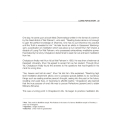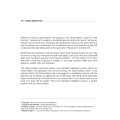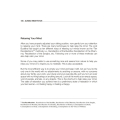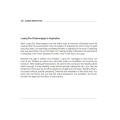dhamma-milk : ค้นหาหนังสือธรรมะ หน้า 11 / 51
หน้าหนังสือทั้งหมด

13
Inaugural Volume of Buddhist Research by Dhammachai International Research Institute
Inpirational Message
On the 44th Anniversary of the Ordination of Most Venerable Founder Luang Phaw Dhammajayo on 27th August 2012 and also in the historical year of the Buddhajayanti 2600 celebration
On August 27, 2012, the Dhammachai International Research Institute (DIRI) marked the 44th anniversary of Luang Phaw Dhammajayo's ordination and the significant Buddhajayanti 2600. This inaugural rese

44
Qualities of a Stream-Attainer in Buddhism
mentioned in the canon.40
The title ‘son of the Blessed one’ suggests that, through the
Buddha, the person was (re)born to the same plane (bhūmi) to which
the Buddha belongs, i.e., passing beyond the
This text delves into the characteristics of a Stream-attainer, identified as a noble disciple who is reborn to a transcendental plane through the Buddha's teachings. Key qualities include association

52
Understanding the Noble Eightfold Path and Threefold Path in Buddhism
[Right concentration, again, becomes the basis of right views, right aspirations, and other steps of the noble eightfold path, which is now experienced on a higher level, and this spiral-like progress
This text elaborates on the interrelationship between Right Concentration, Right Views, and Right Aspirations as pivotal elements of the Noble Eightfold Path leading to liberation. It discusses the sp

62
Understanding Dhammakāya and the Tathāgata
this sense conveys the meaning that the Tathāgata is the body pertaining to transcendental dhamma or Nibbāna, or he is the body of those transcendent qualities. This is similar to the kammadhāraya com
บทความนี้ตรวจสอบแนวคิดของ ‘dhammakāya’ และการเชื่อมโยงกับ Tathāgata ซึ่งหมายถึงร่างกายของธรรมชาติที่ไพศาลหรือ Nibbāna การศึกษาเสนอว่า ‘dhammakāya’ สามารถแปลได้ทั้งในฐานะคุณศัพท์ หรือคำนามที่ชี้ถึงร่าง

71
Understanding Dhammakāya and Enlightenment
1. The term dhammakāya is related to enlightenment. This agrees with our earlier observation regarding the relation of ‘dhammakāya’ to the Buddha and Paccakabuddhas.
2. Dhammakāya is not exclusive to
The term 'dhammakāya' signifies enlightenment and is not exclusive to the Buddha but can also be attained by his disciples, as indicated by Gotami's reference to 'my dhammakāya.' This term is interpre

76
Understanding the Terms Kevala and Dhammakāya in Buddhist Texts
Generally, the term ‘kevala’ is translated either as ‘only’ or ‘entirely.’ It is observed that, whenever the term appears together with another word that conveys the meaning of ‘emanating,’ ‘illuminat
This text explores the interpretation of key Buddhist terms such as 'kevala', which denotes 'only' or 'entirely', particularly in contexts associated with illumination. The term 'dhammakāya', often li

83
Understanding Dhammakāya in Theravāda Buddhism
In a few passages, however, Sāriputta also refers to the term dhammakāya in the sense of the Buddha’s teaching.150
On the whole, traditional Theravādins interpret the term dhammakāya mostly in the se
This passage examines the term 'dhammakāya' as interpreted in traditional Theravāda Buddhism. It discusses the general view of dhammakāya as reflecting the qualities of the Buddha and the spiritual re

94
Buddhist Manuscript Formats in Dai Region
Volume 98 Khuddaka-nikāya (小阿含经) and Volume 99 Majjhima-nikāya (中阿含经) are all in 5-line to 6-line format manuscripts; Volume 100 Digha-nikāya (长阿含经) is in 4-line to 5-line-format. The jäṭaka Wexiandal
Volume 98 Khuddaka-nikāya and Volume 99 Majjhima-nikāya are primarily in 5-6 line formats, while Volume 100 Digha-nikāya is formatted with 4-5 lines per page. The jäṭaka Wexiandala represents a key Bu

20
ผลของกรรมดีในชีวิตปัจจุบัน
รักษาชีวิตผู้อื่นสดอีกสวยงามในอดีตชาติ ไม่เมียดเมียน ตำรวจ ทำลายชีวิตอื่น ก็จะรู้ได้จากปัจจุบันชาติ คือ ปัจจุบันชาติจจะเป็นผู้มีอายุยืน ไม่ถูกต่อน เบียดเบียนทำลายด้วยเหตุใดทั้งสิ้น ไม่ให้ต้องเป็นผู้ชี
บทความนี้กล่าวถึงความสัมพันธ์ระหว่างอดีตชาติและปัจจุบัน โดยชี้ให้เห็นว่าผู้ที่มีความเมตตาและช่วยเหลือผู้อื่นในชีวิตก่อนหน้าจะมีชีวิตที่ดีในปัจจุบันและมีสุขภาพที่แข็งแรง ผู้ที่เคยรักษาศีลและปฏิบัติธรรม

271
คาถาที่ 6 ของบทที่ 16: ธรรมาธูปรวงศ์
(คาถาที่ 6 ของบทที่ 16) ธรรมาธูปรวงศ์ จ ปราณบุรี
ยาส ตานุตตร ยอดธรรมาวุธ สตูป คมภิรึ สรุปธิวิตี้ ฯ ตตรร
จ สตูปมุขเฏียํ สมุน ป(ศยด ศากายมุนี ชิน อิทิ ปรากฏคนตํ มโนช
เณจ สุวรรณ จ) (Thomas 1916d: 114)
ค
บทนี้กล่าวถึงการเข้าสู่ธรรมชาติที่แท้จริงและการเห็นพระพุทธเจ้าในรูปแบบของรูปปั้นทองคำ ซึ่งเป็นการหยุดยั้งความโลภ โกรธ และหลง โดยการสัมผัสประสบการณ์ภายในที่เกิดจากการปฏิบัติทางจิต การบรรยายนี้เกี่ยวข้อ

70
The Viktor of Absorbing: Insights from Velama Sutta
The Viktor of Absorbing
7. Velama Sutta
"If one were to have a dwelling built and dedicated
to the Community of the four directions, that would be
more fruitful than... if one were to feed a communit
The Velama Sutta emphasizes that the true fruits of spiritual practice are found in building a strong foundation in faith and ethical conduct. Constructing a dwelling for the community is commendable,

27
The Journey of Chaiyaboon in Meditation
One day, he came upon a book titled Dhammakaya written in the format of a sermon by the Great Abbot of Wat Paknam, who said: “Reading books alone is not enough to gain the perfect knowledge of Dhamma.
Chaiyaboon's quest for true understanding of Dhamma led him to the teachings of Khun Yai Chand at Wat Paknam. Through her guidance, he realized the reality of heaven and hell, the importance of medita

104
The Inner Light of Dhamma
This is a cool, refreshing inner light that comes from the Dhamma within. All of us have this inner light within us, but it has been obscured by the Five Hindrances 15 (sensual desires, ill will, apat
This text discusses the inner light that arises from the Dhamma within us, often hindered by sensual desires, ill will, apathy, restlessness, and doubts. It emphasizes mindfulness and meditation as ke

108
Mindfulness and Meditation Techniques
Reflect on what our great teacher has taught us. Our Great Master Luang Pu16 Wat Paknam17 advised us to visualize a crystal sphere and recite the mantra “samma ar- ahang”8 at the same time. Visualizin
Reflecting on the teachings of our Great Master Luang Pu, we learn the importance of visualizing a crystal sphere while reciting the mantra 'samma ar- ahang' to maintain mindfulness. Mindfulness and r

110
Guided Meditation: Relaxing Your Mind
GUIDED MEDITATION 106
Relaxing Your Mind
After you have properly adjusted your sitting position, now gently turn your attention to relaxing your mind. There are many techniques to help relax the min
In this guided meditation, learn how to relax your mind effectively by adjusting your sitting position and focusing on techniques such as the Ten Recollections. These methods include recollections of

124
Luang Por Dhammajayo’s Aspiration
Luang Por Dhammajayo’s Aspiration
After Luang Por Dhammajayo took the yellow robe to become a Buddhist monk he resolved that he would preach only the subject of stopping the mind. Over the past forty
Luang Por Dhammajayo emphasizes the essential practice of stopping the mind in his teachings. His journey from a young monk to a teacher focused on the importance of both reading and practicing Dhamma

10
Meeting Luang Por Dattajeevo: A Personal Reflection
When I first met Luang Por1, it was in the summer of 2008. I had come to visit my son, Luang Pi2 Joshua, during his first year as an ordained monk living at Wat Phra Dhammakaya in Bangkok, Thailand. I
In the summer of 2008, I met Luang Por Dattajeevo at Wat Phra Dhammakaya while visiting my son. Initially intimidating, my interactions with this wise monk transformed my understanding of Dhamma. As t

29
Reflections on Meditation and Teachings of Luang Por
Leaving Luang Por that day, we have no idea when we will ever return. And, so, we say "Good Bye" and thank him for all of his kindness.
He says: "Please continue to meditate and I think you will be v
In this touching reflection, the author recounts a farewell to Luang Por, expressing gratitude for his kindness and wisdom. Luang Por encourages continued meditation practice and shares hopes for the

32
Meetings with a Dhamma Teacher
Meetings with a Dhamma Teacher
for the people he loves… which for him, I found out, is everyone. And that is why he is so stern. He wants people to reach for, and experience, success in their lives,
This text shares a personal journey of learning meditation from a dedicated Dhamma teacher. The teacher, who deeply cares for everyone, emphasizes the importance of reaching for success in meditation

46
Understanding the Buddha's Teachings
"You're asking, 'Why is the mind coarse, boorish, or ill-mannered?' The mind is coarse because of attachment, anger, greed. People are really obsessed with stuff. But the Buddha's mind combines itself
In his teachings, the Buddha discusses the coarseness of the mind due to attachment, anger, and greed. He identifies three groups of people in response to his teachings: true believers, non-believers,
